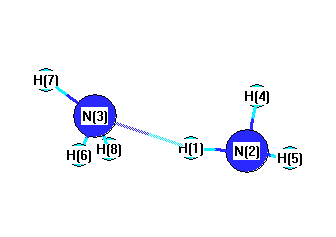Vibrational Frequencies calculated at B1B95/CEP-31G
| Mode Number |
Symmetry |
Frequency
(cm-1) |
Scaled Frequency
(cm-1) |
IR Intensities
(km mol-1) |
Raman Act
(Å4/u) |
Dep P |
Dep U |
|---|
| 1 |
Ag |
3779 |
3618 |
0.00 |
|
|
|
| 2 |
Ag |
3563 |
3412 |
0.00 |
|
|
|
| 3 |
Ag |
1660 |
1590 |
0.00 |
|
|
|
| 4 |
Ag |
815 |
780 |
0.00 |
|
|
|
| 5 |
Ag |
464 |
444 |
0.00 |
|
|
|
| 6 |
Ag |
135 |
129 |
0.00 |
|
|
|
| 7 |
Au |
3808 |
3646 |
13.34 |
|
|
|
| 8 |
Au |
1690 |
1618 |
88.90 |
|
|
|
| 9 |
Au |
255 |
244 |
76.62 |
|
|
|
| 10 |
Au |
104 |
99 |
23.81 |
|
|
|
| 11 |
Bg |
3808 |
3646 |
0.00 |
|
|
|
| 12 |
Bg |
1662 |
1592 |
0.00 |
|
|
|
| 13 |
Bg |
139 |
133 |
0.00 |
|
|
|
| 14 |
Bu |
3778 |
3617 |
73.76 |
|
|
|
| 15 |
Bu |
3571 |
3419 |
27.09 |
|
|
|
| 16 |
Bu |
1651 |
1580 |
83.14 |
|
|
|
| 17 |
Bu |
632 |
605 |
1310.13 |
|
|
|
| 18 |
Bu |
47 |
45 |
225.47 |
|
|
|
Unscaled Zero Point Vibrational Energy (zpe) 15779.3 cm
-1
Scaled (by 0.9575) Zero Point Vibrational Energy (zpe) 15108.7 cm
-1
See section
III.C.1 List or set vibrational scaling factors
to change the scale factors used here.
See section
III.C.2
Calculate a vibrational scaling factor for a given set of molecules
to determine the least squares best scaling factor.
Charges, Dipole, Quadrupole and Polarizability
Charges from optimized geometry at B1B95/CEP-31G
Charges (e)
| Number |
Element |
Mulliken |
CHELPG |
AIM |
ESP |
| 1 |
H |
0.296 |
|
|
|
| 2 |
N |
-0.818 |
|
|
|
| 3 |
N |
-0.818 |
|
|
|
| 4 |
H |
0.261 |
|
|
|
| 5 |
H |
0.261 |
|
|
|
| 6 |
H |
0.296 |
|
|
|
| 7 |
H |
0.261 |
|
|
|
| 8 |
H |
0.261 |
|
|
|
Electric dipole moments
Electric dipole components in Debye
(What's a Debye? See section
VII.A.3)
| |
x |
y |
z |
Total |
| |
0.000 |
0.000 |
0.000 |
0.000 |
| CHELPG |
|
|
|
|
| AIM |
|
|
|
|
| ESP |
|
|
|
|
Electric Quadrupole moment
Quadrupole components in D Å
| Primitive |
|---|
| | x | y | z |
|---|
| x |
-17.102 |
1.493 |
0.000 |
| y |
1.493 |
-8.696 |
0.000 |
| z |
0.000 |
0.000 |
-11.333 |
|
| Traceless |
|---|
| | x | y | z |
|---|
| x |
-7.087 |
1.493 |
0.000 |
| y |
1.493 |
5.521 |
0.000 |
| z |
0.000 |
0.000 |
1.566 |
|
| Polar |
|---|
| 3z2-r2 | 3.132 |
|---|
| x2-y2 | -8.405 |
|---|
| xy | 1.493 |
|---|
| xz | 0.000 |
|---|
| yz | 0.000 |
|---|
|
Polarizabilities
Components of the polarizability tensor.
Units are
Å
3 (Angstrom cubed)
Change units.
| |
x |
y |
z |
| x |
1.285 |
-0.485 |
0.000 |
| y |
-0.485 |
3.152 |
0.000 |
| z |
0.000 |
0.000 |
2.668 |
<r2> (average value of r
2) Å
2
| <r2> |
56.502 |
| (<r2>)1/2 |
7.517 |
